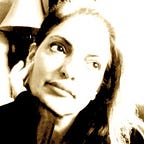ER FLASHBACK
Five years into being symptom-free: A slice of life written 9/26/2008.
I remember the cold, crisp feeling of the O2 combined with Albuterol and the antiseptic scent that flooded my senses as the nervous, respiratory tech put the mask on me with his shaking hands, how my nose would drip from a combination of the O2 and my allergies.
I remember the bright, fluorescent lights, sharp like the prick of the needle that shot epinephrine into my bloodstream and the quick, nervous flurry of movements as a team of ER doctors, nurses and RT worked feverishly.
Poking, pinning, prodding, lifting shirt, listening to lungs, counting breaths, counting beats per minute, assessing the shade of blue in my fingers and around my mouth and nose, asking me questions, asking each other questions, hyper-focused or looking concerned or veiling concerned looks.
My survival required this chaos we all participated in with wide open, wide awake, hyper-awareness. At times I saw stars, my head floated as I fought to maintain consciousness. My connection to the team was a connection to life itself while gripping life’s edge in the ER.
They put the mask on me when my lung capacity was so low I was unable to hold nebulizer to face. A thing that weighed ounces, and yet, it was too much for me to hold up in that state.
I know precisely how much breath one needs to stay conscious. I know exactly how to slow my breathing down and use my diaphragm. I know how to ignore lung pain.
The last time I panicked, I was 7 yrs old.
As the drugs entered through my veins, I felt them in my kidneys, and soon enough, they would relieve my lungs.
Visualizing the inflammation in my lungs easing from steroids as I felt the adrenaline based meds expand constricted lungs required patience, confidence, calmness. This process insisted I remain in denial about death looming over.
Thoughts of death are not an option in the ER. My concentration was on getting enough breath together to share with doctors, nurses, and RT all necessary information about their severely distressed patient. We were hyper-focused together, or it wouldn’t work.
With large, round, expressive eyes, I could communicate quite well without words. Part of me was calming the newbies and bringing the seasoned pros to space where they could recognize me as an individual. The team became immediately aware that I was an informed patient who was as self-sufficient as possible. If I had my backpack or purse, I shared a daily peak flow chart and a list of alternative healing modalities that I combined with modern medicine to stay alive.
I made sure they knew I wasn’t ignoring mainstream healing methods; I was actively combating side effects with healthy alternatives.
It was going to take more than a nebulizer treatment (I had that at home) or a shot of epi (also at home) or going to a happy place (I was in a semi-trance like, meditative state). Severe asthma required more than reiki, pranayama, ephedra, coffee, meditation, herbal therapies, acupressure, acupuncture, theophylline, epinephrine, oral prednisone, Albuterol, and a positive attitude. Within moments, they’d realize intravenous meds were necessary. The team worked quickly to prevent the need for intubation; there was no time to wait for blood gas results.
The paperwork I shared informed the team what the usual Medrisol or Solumedrol dosage was and that although I avoided it, I also knew it was an immediate necessity. The paperwork didn’t always make it to the ER with us, and the dose would be too high or low if I couldn’t get the numbers out. Paramedics don’t hesitate or look for shoes and purse when you’ve turned blue. Lack of O2 forced the most succinct communication.
Did my eyes express appreciation for the EMT’s life-saving measures? EMT’s often asked, “Why did you wait so long to call us?” I hadn’t waited. I was doing what I could from home, knowing that without insurance, the trip to the ER that I was so grateful for was going to cost well over two grand within the first hour.
After a lifetime of this routine, including an episode that lasted 12 days (unconscious) finishing with a proper pronouncement of death / near-death experience — I’ve been symptom-free for 17 years. Thank you, Advair and Singulair.
Asthma provided many gifts:
yoga, meditation, nutritional and herbal knowledge- I became certified in a variety of alternative healing modalities.
I learned that magical thinking and spiritual bypass could be deadly (another story for another day). I learned that ancient and modern modalities could complement each other. I learned.
Asthma was the first to teach me about frugality, negotiating rates, and paying off large sums of money. It took many years to pay off medical bills. I’ve been medical bill debt free for over a decade now.
And the greatest gift: When others panic, I stay calm.
